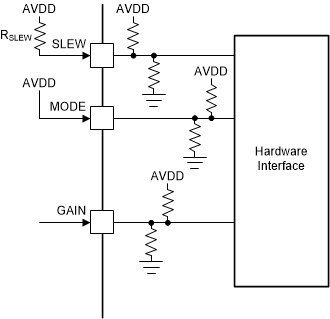SLVSFN2B September 2021 – February 2022 DRV8311
PRODUCTION DATA
- 1 Features
- 2 Applications
- 3 Description
- 4 Revision History
- 5 Device Comparison Table
- 6 Pin Configuration and Functions
- 7 Specifications
-
8 Detailed Description
- 8.1 Overview
- 8.2 Functional Block Diagram
- 8.3
Feature Description
- 8.3.1 Output Stage
- 8.3.2 Control Modes
- 8.3.3 Device Interface Modes
- 8.3.4 AVDD Linear Voltage Regulator
- 8.3.5 Charge Pump
- 8.3.6 Slew Rate Control
- 8.3.7 Cross Conduction (Dead Time)
- 8.3.8 Propagation Delay
- 8.3.9 Pin Diagrams
- 8.3.10 Current Sense Amplifiers
- 8.3.11 Protections
- 8.4 Device Functional Modes
- 8.5 SPI Communication
- 9 DRV8311 Registers
- 10Application and Implementation
- 11Power Supply Recommendations
- 12Layout
- 13Device and Documentation Support
- 14Mechanical, Packaging, and Orderable Information
Package Options
Mechanical Data (Package|Pins)
- RRW|24
Thermal pad, mechanical data (Package|Pins)
Orderable Information
8.3.3.2 Hardware Interface
Hardware interface devices omit the four SPI pins and in their place have nSLEEP pin and three resistor-configurable inputs which are GAIN, SLEW and MODE.
Common device settings can be adjusted on the hardware interface by tying the pin logic low, logic high, or pulling up or pulling down with a resistor. Fault conditions are reported on the nFAULT pin, but detailed diagnostic information is not available.
- The GAIN pin configures the gain of the current sense amplifier.
- The SLEW pin configures the slew rate of the output voltage to motor.
- The MODE pin configures the PWM control mode and OCP level.
For more information on the hardware interface, see Section 8.3.9.
Table 8-5 Hardware Pins Decode
| Configuration | GAIN | SLEW | MODE |
|---|---|---|---|
| Pin tied to AGND | 0.25 V/A | 35 V/us | 6x PWM Mode and 9A OCP Level |
| Pin to 47 kΩ tied to AGND | 0.5 V/A | 75 V/us | 6x PWM Mode and 5A OCP Level |
| Pin to Hi-Z | 1 V/A | 180 V/us | 3x PWM Mode and 9A OCP Level |
| Pin tied to AVDD | 2 V/A | 230 V/us | 3x PWM Mode and 5A OCP Level |
Figure 8-14 DRV8311 SPI Interface
 Figure 8-15 DRV8311 Hardware Interface
Figure 8-15 DRV8311 Hardware Interface